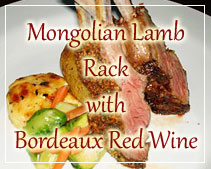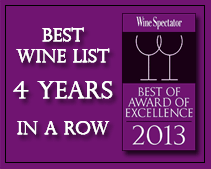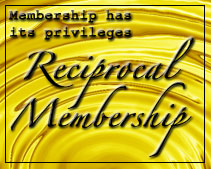French Cuisine
April 28,2011
Despite a common pan-gallic chauvinism, French cooking is not a monolith: it ranges from the olives and seafood of Provence to the butter and roasts of Tours, from the simple food of the bistro to the fanciful confections of the Tour d’Argent. However, it all shares a seriousness about food. Throughout the country, French cooking involves a large number of techniques, some extremely complicated, that serve as basics. Any cook will tell you that French food will not tolerate shortcuts in regard to these fundamentals. Because mastery of sauces or pastry doughs is the center of the culinary arts, recipes themselves remain classic and constant. In a way similar to Japanese cuisine, it is expected that even the simplest preparation be undertaken in the most careful manner, which means disregarding the amount of time involved. This is one reason why French cooking has always seemed so daunting on the other side of the Atlantic. Americans love nothing more than combining innovation with time-saving; it is the particular genius of the United States, and it couldn’t be more at odds with the French aesthetic.
Not only do basic cooking techniques require great skill, but an they also demand a deep understanding of the ingredients themselves. Just as the vintner knows that the finest Bordeaux comes from the grapes grown on that side of the hill and not this, so too the chef knows not only from which region come the finest petits pois (small, young green peas), but from which town — the same goes for asparagus, and even cauliflower. If there is something worth eating, and cooking, there is a best representative of such. Many foods are known by the town that made them famous, such as Pessac for strawberries, the peas of Saint-Germaine, Macau artichokes, the Charollais steer, butter of Isigny.
The French and English adapted service à la russe, in which courses are served separately, in the middle of the 19th century. A French meal might begin with a hot hors d’oeuvre (or for luncheon, a cold hors d’oeuvre) followed by soup, main course, salad, cheese,and finally dessert. The French operate with a strong sense that there is an appropriate beverage for every food and occasion. Wine is drunk with the meal, but rarely without food. An aperitif (a light aloholic beverage such as Lillet) precedes the meal and a digestif (something more spirited — say, cognac) may follow. This close relationship between food and wine may, in part, closely parallel the evolution of great cooking and great wine making. It is probably not coincidental that some of the best cooking in France happens in some of her finest wine-growing regions. In Burgundy, Bordeaux, Provence, and Touraine, wine is as prevalent in the cooking process as it is in the glass. Champagne as a beverage doesn’t accompany food gracefully, likewise, as a region it is not well known for its food. One notable exception to this rule (and there are of course others) is Normandy, who, from her fantastic butter, cream, cheese, apples and the riches of the sea, has produced a marvelous local cuisine without the help of wine. However, the local Calvados, an apple based eau-de-vie, may also explain the phenomenon.
The French are predominantly Catholic and thus have no eating prohibitions, though many dishes have a Lenten variation. Moreover, the Gauls are not afraid to eat anything. Kidney, brain, sweetbreads, tripe, blood sauces and sausages, sheep’s foot, tongue, and intestines are all common in French cooking and hold equal standing with the meat of lamb, beef, pork, poultry, and game. Quite the opposite of being exotic, these foods are at the heart of the bourgeois menu, with seafood inevitably being the soul, and vegetables, the flesh.
Source: http://www.cuisinenet.com/glossary/france.html
Manila is fast becoming a city of luxurious fine dining accompanied by fine vintage wine. Not only must a 5-star Italian, French or Continental restaurant offer good food, nice ambience and immaculate service the restaurant wine list must be equally exciting to make the evening of wine and dine a memorable one.
This 5-star fine dining restaurant in Pampanga Philippines is highly recommended by food critics and frequent diners in Manila as a place to wine and dine in Subic Angeles City Clark Freeport Zone. Although it is a famous fine dining restaurant with an award winning 3000-line restaurant wine list, Yats Restaurant is also a popular restaurant for family with children. Aside from French Mediterranean haute cuisine, this restaurant also serves healthy food and the best vegetarian cuisines in the Philippines. Private dining rooms are also available in this restaurant for business and personal meetings of 4 to 20 people.
Favorites of frequent diners, foodies and wine lovers are steaks, Wagyu, Foie Gras, seafood, lobsters, venison, kangaroo loin, osso buco, veal chops, Kurabuto pork, escargots and a good selection of cheeses to enjoy with fine Vintage port and Sauternes. Cuban cigars such as Monte Cristo, Cohiba, Upmann, Partagas, Romeo Julieta and Trinidad are also available in the Magnum Room which is a wine bar and lounge for before and after dinner relaxation. A good selection of Armagnac, Cognac, Single Malt, Vodka and other liquor is served in addition to the wine vintage wines some served by the glass.
Built in 2000 by Hong Kong-based Yats International, a developer and operator of hospitality and residential projects in the Philippines, fine dining Yats Restaurant and Wine Bar has served not only as Pampanga’s highly recommended restaurant and wine lounge, but also as a place where business executives meet to finalize business deals over a nice meal with some fine vintage wine.
For comments, inquiries and reservations click on Click here for inquiry and reservations
Restaurant@Yats-International.com
(045) 599-5600
0922-870-5178
0917-520-4401
Ask for Pedro and Rechel
Getting to this fine dining restaurant of Angeles City Clark Freeport Zone Pampanga Philippines
How to get to this fine-dining restaurant in Clark Philippines? Once you get to Clark Freeport, go straight until you hit Mimosa. After you enter Mimosa, stay on the left on Mimosa Drive, go past the Holiday Inn and Yats Restaurant (green top, independent 1-storey structure) is on your left. Just past the Yats Restaurant is the London Pub.
Yats Restaurant & Wine Bar
Mimosa Drive past Holiday Inn, Mimosa Leisure Estate,
Clark Freeport Zone, Pampanga, Philippines 2023
Manila Sales Office
3003C East Tower, Phil Stock Exchange Center,
Exchange Rd Ortigas Metro Manila, Philippines 1605
(632) 637-5019 0917-520-4393 Rea or Chay
For any assistance in planning and organizing a wedding ceremony, indoor or outdoor garden reception or to find other wedding service providers, Click here to contact us click here
For assistance in hotel and resort bookings in Clark, Pampanga, Philippines, log on to
http://www.HotelClarkPhilippines.com
To buy wine in Manila, Pampanga, Angeles City, Clark or Subic please log on to http://www. ClarkWineCenter.com
To inquire with the highly recommended beach resort hotel in Clark Pampanga visit http://www.ClearwaterPhililippines.com
For more information about Clark, Pampanga, Philippines log on to
http://www.ClarkPhilippines.com









